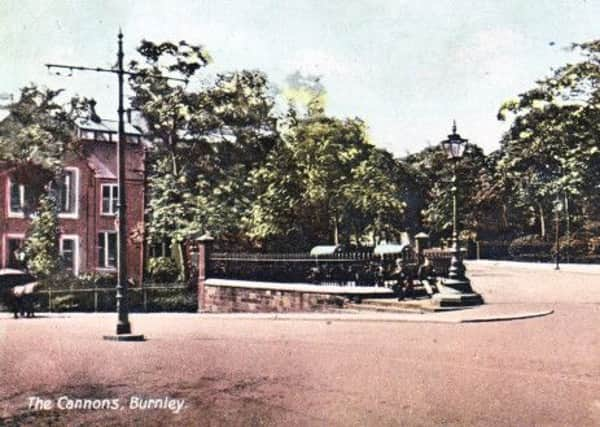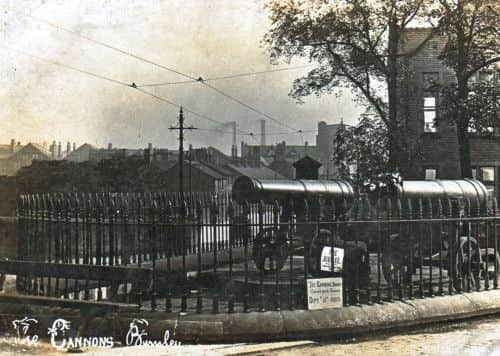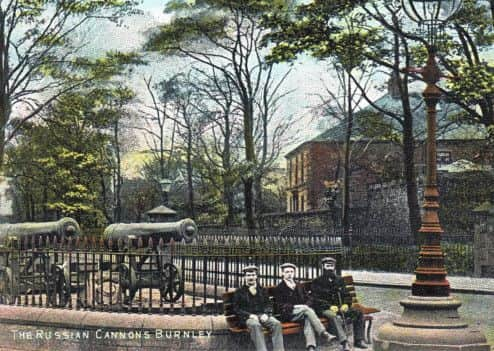Cannons were spoils of war from Russians


“The Cannons”, the young man said, as he took his seat on the upper deck of the BCN bus at Lane Head.
A ticket was issued with great speed and accuracy by the clippie.
The young man thought nothing of it.


Advertisement
Hide AdAdvertisement
Hide AdHe did this five days a week, the first stage of his journey to work. He was on his way, by Station Approach, to Burnley Bank Top railway station where he would get on a steam train to Preston. The return journey was undertaken in reverse, except when he fell asleep and ended up in a small siding in Colne or, worse still, at a similar location in a dark and forbidding Skipton.
There was no such problem in Preston. He was too wide awake, thinking about the day’s work at County Hall, for him to fall asleep and, if he did, Blackpool had its compensations!
The young man is imaginary but the journey, with alternative destinations – Accrington, Blackburn etc – was taken, on a daily basis by quite a number of Burnley people.
One of them was my father who got on the double decker at Queen Street, Harle Syke. He also asked for “the Cannons” though I suspect that, occasionally, he might have uttered the words “Station Approach” and get off at the same stop by the high wall of Bank Hall, then Burnley’s maternity hospital.


Advertisement
Hide AdAdvertisement
Hide AdThis little remembrance of the past is of little consequence but have you noticed we no longer use some of the names mentioned in the extract?
Of course, it is the same in other parts of town.
Who refers to Rakehead Recreation Ground by its proper name of St Andrew’s Recreation Ground?
When was the area, between Church Street and the canal, last referred to as Hill Top or Scar Top?
When did you last hear the bottom end of Parker Lane given its original name of Lane Bridge?
Advertisement
Hide AdAdvertisement
Hide AdThe same is true of “the Cannons” and you can see why in the splendid postcard images which accompany this short article.
Similarly, we no longer refer to the paved walkway through Thursby Gardens as “Station Approach”, which is its actual name. How many of you know Thursby Gardens is the proper name of the little green area adjacent to Prestige Park?
In addition, no one refers to Burnley Central – something of a misnomer, I have always thought – as Burnley Bank Top, its first name, and nearby Bank Hall has not occupied its historic spot for approaching 30 years.
The latter name is still used for the retirement home now on the site but the large house, once the home of General Scarlett, has been consigned to history.
Advertisement
Hide AdAdvertisement
Hide AdThe building was allowed to rot by managers at the NHS, the process starting long before the hospital closed and its patients transferred to a new facility at Burnley General.
One of the cards used today is entitled “The Russian Cannons, Burnley” and it is likely younger readers will not know the particular connection between Burnley and Russia.
It was a long time ago, before the Communist Revolution, when Russia was ruled by the Romanov Czars.
The powers of Western Europe, but particularly Britain, had long since been afraid Russia might take advantage of a weak Turkey to gain easy access to the Mediterranean Sea and, possibly, Britain’s “jewel in the Crown”, India.
Advertisement
Hide AdAdvertisement
Hide AdThe result was the Crimean War which was fought from 1854 to 1856.
There had been a dispute between the Russians and Turks about the guardianship of the Holy Places in Jerusalem and, to cut a long story short, the British, French and Prussians found themselves defending Turkey against Russian aggression.
The Crimean War was one in which a number of local men fought, General the Hon. Sir James Yorke Scarlett being the most well-known.
The cannons, as is shown in the second card, were captured from the Russians on September 8th, 1855, when Sebastopol fell and the Russian fortresses at Malakof, and at the Redan, were taken by the allies by assault.
Advertisement
Hide AdAdvertisement
Hide AdAs the second card was printed on the Jubilee of the fall of Sebastopol we know it was made in 1905.
The card is of an obscured view down Church Street with a few of the houses of the Top o’ th’ Town area visible and part of the taller Old Sparrow Hawk just in the picture. To its right you can see the most recent wing of the Old Burnley Grammar School and, apart from the loss of the mill chimneys little has changed in this picture.
The picture with the three men sitting on a bench in front of “the Cannons” is a better photo.
It was posted in 1906 and, in it, you can see there are two cannons. They remained in place from the mid 1860s to the years of the Second World War when they were taken for making into weapons, this time to fight the Germans who had been our allies against Russia in the 1850s. Of course, this time, the Russians were on “our side”!
Advertisement
Hide AdAdvertisement
Hide AdThe cannons were taken to Portsmouth for processing but, when they were examined, it was found they were made out of an alloy which could not be used again for military purposes. They were, therefore, taken out to sea and dumped at Spithead when it would have been just as easy to return them to Burnley where they had an honoured place in people’s affections.
I can hear some of you saying “there was a War on, you know”, but I am afraid this does not wash with me. The guns should have been checked before they were sent for melting down and, to my mind, should not have been taken in the first place.
I ask myself, how many of the old guns at the Tower of London were destined for the fate which befell our Crimean Guns in Burnley?
This picture is also interesting as it shows Brown Hill, the large house on the right.
Advertisement
Hide AdAdvertisement
Hide AdI remember the building in its later years when the Prestige factory, and its later additions, dominated the area now occupied by Sainsbury’s and a few other large stores. The house was built in 1819, one of a number of impressive buildings constructed in Burnley that year. Another was the Bull Hotel in Burnley Centre but both of them have now gone.
Brown Hill was built by a member of the Burnley banking family of Holgate’s. The Holgates, a partnership of three brothers, in the late 18th and early 19th Centuries, were Burnley’s biggest industrialists.
Not only were they bankers, in their own right, with offices in Burnley, they were also brewers, wine and spirit importers, wool merchants and were also engaged in the cotton industry.
Only five years after the building of Brown Hill the Holgate’s commercial enterprises came crashing down when their bank collapsed in 1824.
Advertisement
Hide AdAdvertisement
Hide AdI have written about the fall of Holgate’s Bank, and its economic effect on Burnley, in other articles in the Express. Here, all I will say is the incident was almost catastrophic.
The collapse of the Bank, which was brought about by the insolvency of Tattersall and Crook, one of their leading customers, and another of Burnley’s leading commercial enterprises, resulted in numerous firms, in different sectors, becoming bankrupt. The pages of the local press were filled with details of bankruptcies. It is likely thousands of people lost their jobs in a now almost forgotten tragedy.
I do not think have used the third of today’s cards in any of my articles in the series I write for the Express.
It was not all that long ago that the card was acquired. The makers were Jackson and Son of Grimsby who produced very distinctive cards. This one was posted, I think, in 1913. I am not absolutely sure as the date of postage has not been franked properly but the card is of a scene taken from the pavement adjacent to Bank Hall’s garden wall.
Advertisement
Hide AdAdvertisement
Hide AdOn the extreme left there is a horse and cart making its way up the hill on the first part of Colne Road. Further to the right, one of the columns which carried overhead cables for the trams can be seen. In the middle is the lamp post which is also visible on the second card. It was, of course, one of Burnley’s “Gawmlesses”, though this one has been rescued by the council and placed in the paved area by the bench on which two men are sitting.
Taking the theme of this article a little further, we no longer refer to our street lights as “gawmlesses” though, perhaps some of us use the word for those who operate them!